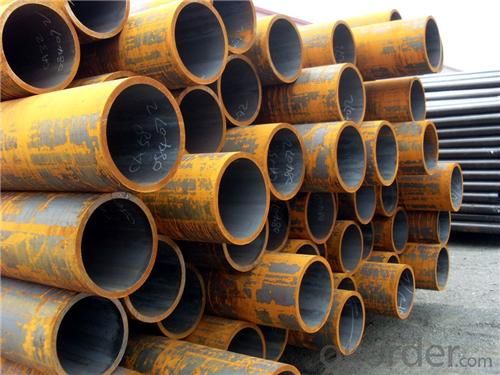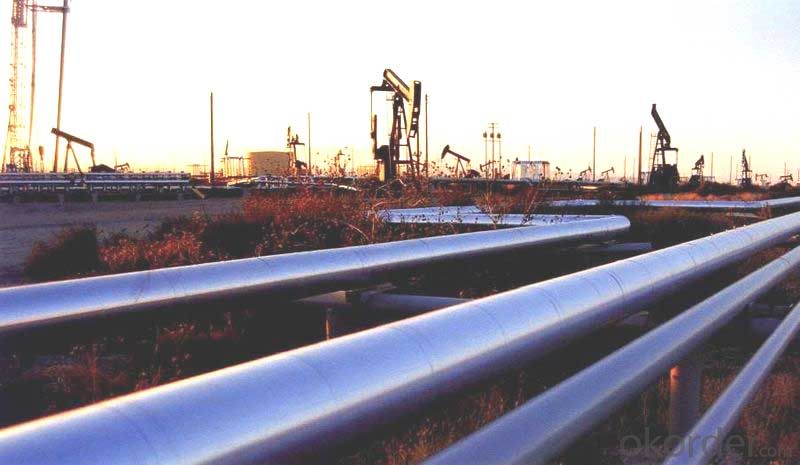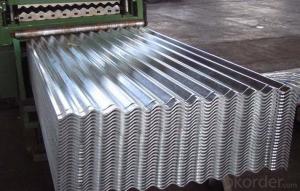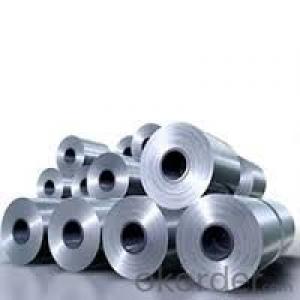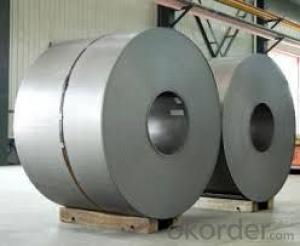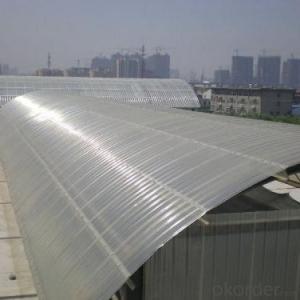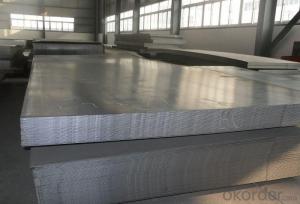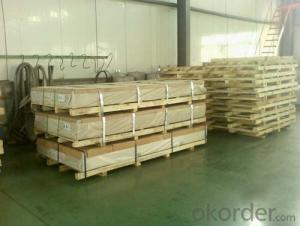Steel Sheets for Pipe Container Base Metal for CR
- Loading Port:
- Tianjin
- Payment Terms:
- TT OR LC
- Min Order Qty:
- 500 m.t.
- Supply Capability:
- 5000 m.t./month
OKorder Service Pledge
OKorder Financial Service
You Might Also Like
Specification
1. Product Description
Far less cold hot rolled steel plate, mechanical properties, but also is inferior to the forging processing, but has good toughness and ductility cold-rolled steel sheet due to a certain degree of strain hardening, toughness is low, but can reach better showed, used for cold bending spring pieces and parts, at the same time due to the yield point is close to the tensile strength, so no foresight to danger, in use process in the load exceeds allowable load are prone to accidents
2. Main Features
Characteristics of hot rolled steel hot-rolled steel is a high temperature heating and rolled steel, hot rolled product has high strength, good toughness, easy to processing molding and good weldability and other excellent properties, which are widely used in ship, automobile, Bridges, buildings, machinery, pressure vessels and other manufacturing industries.
3. Excellent Product Image
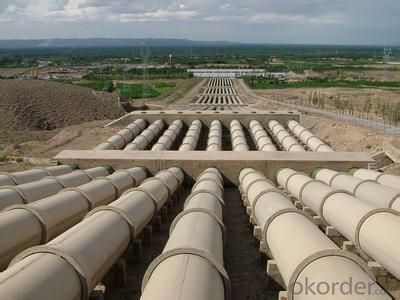
4. Application
, cold rolled plate
Used in the production of all kinds of cold rolled products, including CR, GI, width, etc.
, steel pipes with steel plate
Has good processing properties and the compressive strength, for the production of content product 500!Under \ u0013 filling LPG, acetylene, and high pressure gas pressure vessels of various kinds of gas.
, high pressure vessel steel plate
Has good processing properties and the compressive strength, for the production of content product 500!Under \ u0013 filling LPG, acetylene, and high pressure gas pressure vessels of various kinds of gas.
5. FAQ
1.Q: Do you have attended any exhibition?
A: We almost go to Canton Fair and Overseas Exhibitions every year.
2. Q: How to guarantee the quality of the products?
A: We have established the international advanced quality management system,every link from raw material to final product we have strict quality test;We resolutely put an end to unqualified products flowing into the market. At the same time, we will provide necessary follow-up service assurance.
3. Q: How long can we receive the product after purchase?
A: Usually within thirty working days after receiving buyer’s advance payment or LC. We will arrange the factory manufacturing as soon as possible. The cargo readiness usually takes 15-25 days, but the shipment will depend on the vessel situation.
Why choose us?
Pre-sale Service
1. Sample can be offered with sample charge and courier fee by buyer's side.
2. We have full stock,and can deliver within short time.Many styles for your choices.
3. OEM and ODM order are accepted, Any kind of logo printing or design are available.
4. Good Quality + Factory Price + Quick Response + Reliable Service, is what we are trying best to offer you
5. All of our products are produce by our professional workman and we have our high-work-effect foreign trust-worthy sales team.
6. We have 18 years' experience of design, manufacture and sell lingerie, we cherish every order from our honor.
After you choose
1. Count the most efficient shipping cost and make invoice to you at once.
2. Check quality again, then send out to you at 1-2 working day after your payment.
3. Email you the tracking no, and help to chase the parcels until it arrive you.
- Q: Do the steel sheets have any sharp edges?
- Indeed, sharp edges can be found on steel sheets. Throughout their production, steel sheets frequently undergo cutting or shearing processes, thereby resulting in the presence of sharp edges. It is of utmost importance to exercise caution when dealing with steel sheets and to employ suitable protective gear, like gloves, while working with them, in order to prevent any harm arising from the sharp edges.
- Q: How do steel sheets compare to galvanized sheets?
- Both steel sheets and galvanized sheets find extensive use across various industries and applications, but they possess distinguishing characteristics that render them appropriate for different purposes. Constructed from robust and enduring low carbon steel, steel sheets exhibit remarkable strength, making them suitable for a wide array of applications, including construction, automotive manufacturing, and fabrication. With varying grades and thicknesses available, steel sheets offer versatility in their usage. When adequately maintained, they provide exceptional strength and resistance against corrosion. Contrarily, galvanized sheets are essentially steel sheets coated with a zinc layer via galvanization. This coating forms a protective barrier against corrosion, thus extending the sheet's lifespan. Galvanized sheets are commonly employed in outdoor applications, where exposure to moisture and harsh weather conditions poses a concern, such as roofing, fencing, and outdoor signage. In comparison to steel sheets, galvanized sheets possess heightened corrosion resistance and tend to endure longer in outdoor environments. However, they may not exhibit the same level of strength as steel sheets and can be more costly due to the galvanization process. Moreover, the zinc coating imparts a distinctive lustrous appearance to galvanized sheets, resulting in a more visually pleasing finish. To summarize, steel sheets exemplify strength, versatility, and suitability for diverse applications, whereas galvanized sheets offer superior corrosion resistance and prove ideal for outdoor usage. The ultimate selection between the two hinges on project-specific requirements, considering factors such as strength, durability, corrosion resistance, and budget.
- Q: What are the standard sizes of steel sheets?
- The standard sizes of steel sheets vary, but some common dimensions include 4x8 feet, 4x10 feet, and 5x10 feet.
- Q: What is the minimum order quantity for steel sheets?
- The minimum order quantity for steel sheets can vary depending on the supplier, but it is typically around 1 ton or 1000 kilograms.
- Q: What is the maximum length of steel sheets?
- The maximum length of steel sheets can vary depending on the manufacturer and specific application, but it is typically around 40 feet (12 meters) for standard commercial steel sheets.
- Q: Can steel sheets be used for interior wall cladding?
- Yes, steel sheets can be used for interior wall cladding. Steel sheets provide a durable and modern aesthetic, making them suitable for various interior design styles. They can be used in commercial and residential spaces to add an industrial and sleek look to the walls.
- Q: Can steel sheets be used in HVAC systems?
- Yes, steel sheets can be used in HVAC systems. Steel is a commonly used material in HVAC systems for various components such as ductwork, air handling units, and heat exchangers. It is durable, strong, and can withstand high temperatures and pressures, making it suitable for HVAC applications.
- Q: Can steel sheets be used in construction projects?
- Yes, steel sheets can be commonly used in construction projects. They are versatile, durable, and provide strength and stability to structures. Steel sheets are often used for roofing, flooring, walls, and various structural components in buildings.
- Q: Are steel sheets suitable for architectural cladding?
- Architectural cladding can indeed utilize steel sheets. Steel possesses durability and versatility, offering an array of advantages for cladding applications. Its strength and rigidity enable it to withstand harsh weather conditions, including strong winds, heavy rain, and snow. This durability ensures that the cladding will endure for many years without requiring frequent maintenance or replacement. Additionally, steel sheets provide a sleek and modern aesthetic to buildings. They can be finished in various ways, such as painting, powder coating, or applying a metallic finish, allowing for limitless design possibilities. Steel cladding can achieve a contemporary or industrial look, making it a favored choice for both commercial and residential structures. Steel sheets are also highly resistant to fire, pests, and rot, making them a safe and long-lasting option for cladding. Furthermore, they are relatively lightweight, which can reduce construction costs and simplify installation. Furthermore, steel is an environmentally friendly material. It is recyclable, making it a sustainable choice for cladding. Steel cladding can also enhance energy efficiency by providing better insulation and reducing heat transfer, resulting in reduced energy consumption for heating and cooling. In conclusion, steel sheets are a suitable choice for architectural cladding due to their durability, aesthetic appeal, safety features, sustainability, and energy efficiency benefits.
- Q: Can steel sheets be used for electrical motors?
- Yes, steel sheets can be used for electrical motors. Steel is commonly used in the construction of electrical motors due to its magnetic properties. The sheets of steel are typically used to create the core of the motor, which is responsible for generating the magnetic field necessary for the motor's operation. Steel has a high magnetic permeability, which means it can easily conduct and channel magnetic flux, making it an ideal material for this purpose. Additionally, steel is durable and can withstand the high temperatures and mechanical stresses that electrical motors may experience during operation. Therefore, steel sheets are often chosen as a reliable and cost-effective option for constructing electrical motors.
Send your message to us
Steel Sheets for Pipe Container Base Metal for CR
- Loading Port:
- Tianjin
- Payment Terms:
- TT OR LC
- Min Order Qty:
- 500 m.t.
- Supply Capability:
- 5000 m.t./month
OKorder Service Pledge
OKorder Financial Service
Similar products
Hot products
Hot Searches
Related keywords




